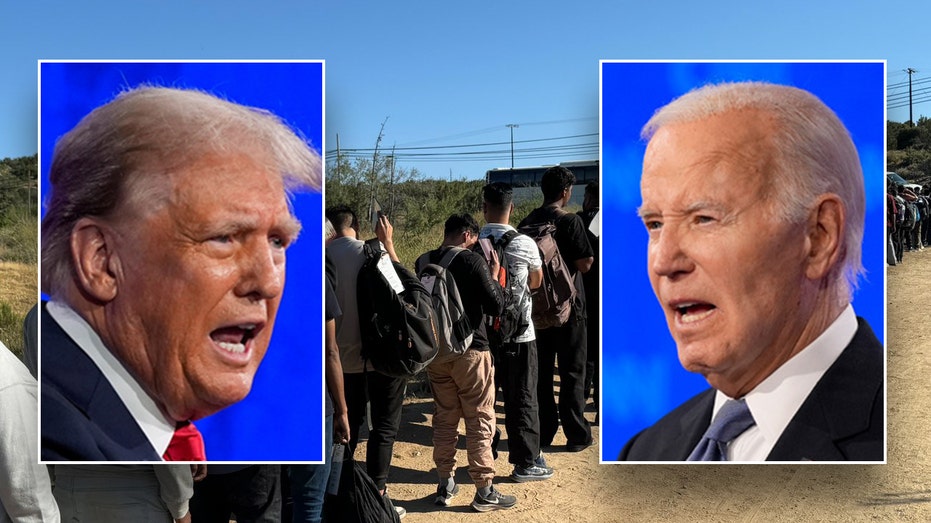During the CNN Presidential Debate on Thursday, former President Trump hailed the success of the “Remain in Mexico” policy — a controversial border program he has touted repeatedly and which many conservatives have called for in a potential second Trump term.
Trump repeatedly hammered President Biden on the ongoing crisis at the southern border during the debate and attempted to contrast his record with Biden’s. A core part of his efforts to bring immigration numbers down was the introduction of the Migrant Protection Protocols (MPP), commonly called “Remain in Mexico.”
Expanded in 2019 across multiple ports of entry, the program involved an agreement with Mexico to set up tent courts to which migrants could go to apply for asylum and then wait in Mexico as they had their claims heard, rather than being released into the U.S.
TRUMP REPEATEDLY HAMMERS BIDEN ON BORDER CRISIS TURNING US INTO ‘RAT’S NEST’: ‘KILLING OUR PEOPLE’
“[Biden] ended ‘Remain in Mexico.’ I ended ‘catch and release.’ I made it ‘catch and release’ in Mexico, not ‘catch and release’ here. We had so many things that we had done, hard negotiations with Mexico, and I got it all for nothing,” Trump said Thursday.
Supporters of the program said that, where applied, the policy — where it was implemented — essentially ended “catch and release,” by which migrants are released into the U.S. to await their hearings, which can take years. While only around 70,000 migrants were returned under the program, conservatives have highlighted it as a move that was followed by a drop in encounters that summer and into pre-COVID 2020.
The Biden administration shut down the program in 2021, arguing that the policy was ineffective and left migrants in squalor and in danger in Mexico, leading to massive migrant camps set up along the border as people waited for their appointments — an argument also made by immigration advocates.
“As [Homeland] Secretary [Alejandro] Mayorkas has said, MPP has endemic flaws, imposes unjustifiable human costs, and pulls resources and personnel away from other priority efforts to secure our border,” the Department of Homeland Security (DHS) said in a statement in 2022 as it moved to end the program.
Since then, the Biden administration has introduced a number of its own measures to regulate immigration and relieve pressure at the border amid a massive migrant surge that spiked in 2021. At the heart of its policy is an expansion of the CBP One app, allowing migrants to enter legally and schedule an appointment to be paroled into the U.S. Currently, that allows about 1,500 migrants each day.
DHS Secretary Mayorkas recently noted that that amounts to 500,000 people a year, and is in addition to other measures put in place to prevent migrants making the journey to the border.
BLUE STATE DEPLOYS OFFICIALS TO THE BORDER WITH SURPRISING WARNING FOR MIGRANTS
“CBP One is not the only access point to humanitarian relief in the United States. The number of individuals accessing CBP One is in addition to the 30,000 people accessing the Cuban Haitian Nicaraguan Venezuelan program. It is in addition to the individuals accessing the refugee program in the Western Hemisphere, which has grown exponentially to an unprecedented level. It is in addition to the people who are accessing our safe mobility offices in Colombia, Ecuador, Costa Rica, Guatemala, those safe mobility offices are expanding,” he said.
The administration has also pointed to various instances of cooperation with Mexico, including its agreement to accept tens of thousands of illegal immigrants back each month, and efforts with countries including Mexico to counter human smuggling. On Thursday, Biden touted cooperation with Mexico on stopping fentanyl crossing into the U.S.
“We’re coming down very hard in every country in Asia in terms of precursors to fentanyl, and Mexico is working with us to make sure they don’t have the technology to be able to put it together,” he said.
Yet reports of significant backlogs at the border remain, with advocates pointing to efforts by the administration to block asylum for those crossing illegally as inhumane, and arguing that more needs to be done to allow more migrants in.
“With increasing wait times and uncertainty about appointment allocation, many asylum seekers are forced to make perilous decisions to cross into the United States without appointments, putting their lives at risk and potentially being ineligible for asylum because of the Asylum Ban,” a recent report by Amnesty International said.
CLICK HERE FOR MORE COVERAGE OF THE BORDER SECURITY CRISIS
The organization argues that the app poses technological barriers and other limitations, with what it sees as limited appointments being handed out at random.
“The CBP One application turns the legal right to asylum into a lottery system based on chance.” said Paul O’Brien, executive director of Amnesty International USA. “Asylum seekers may never be provided with safety and protection in the United States simply because they may never receive an appointment.”
Within that lens, a return to “Remain in Mexico” would make the situation worse for asylum seekers, particularly if a Republican administration shut down the parole appointments through CBP One.
But supporters argue that it is allowing migrants in which creates more demand, and that the key to ending the backlog beyond the border is ending the pull factors.
Any return to “Remain in Mexico” would also face a significant hurdle in securing cooperation from Mexico. While the Trump administration got the Mexican government to cooperate in 2019, the Mexican foreign ministry has since said it won’t cooperate with any reintroduction of MPP.
























